Name the straight-chain alkanes or cycloalkanes whose structure or formula is shown:
(b)

 Verified step by step guidance
Verified step by step guidance Verified video answer for a similar problem:
Verified video answer for a similar problem:



 :36m
:36mMaster Rules for Naming Cyclic Alkanes Concept 1 with a bite sized video explanation from Jules
Start learning